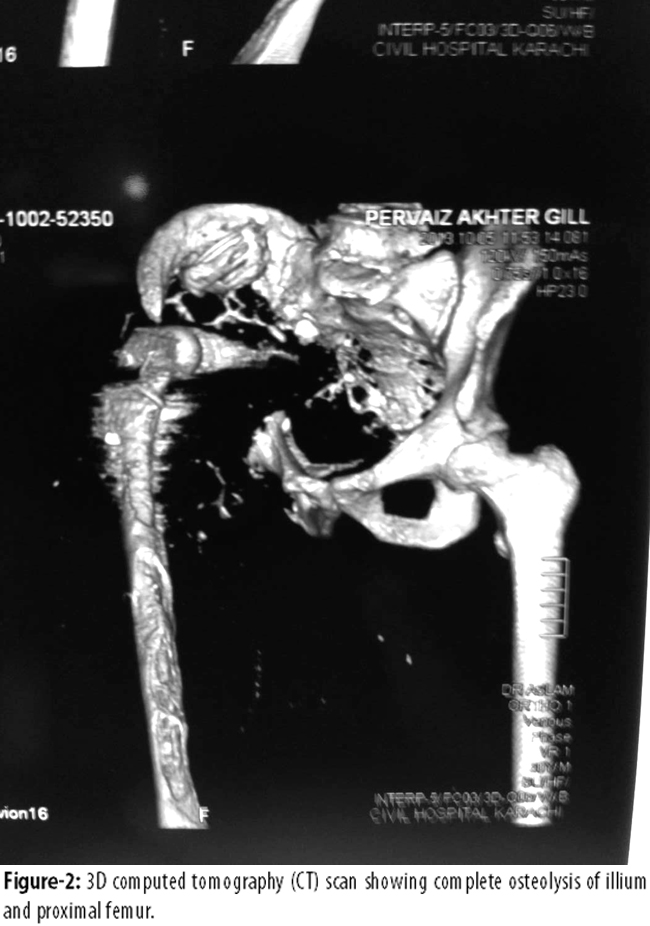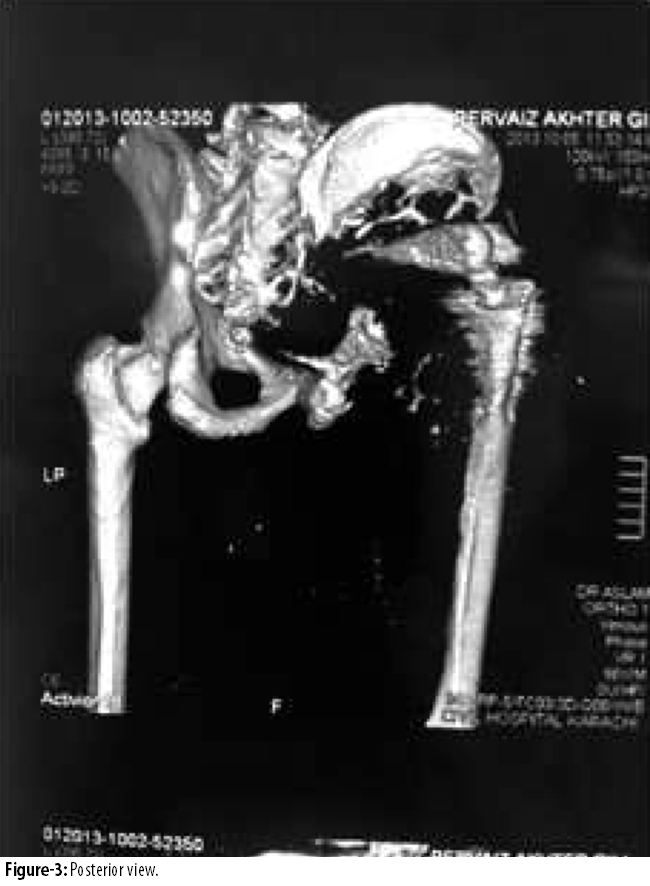Authors: Badaruddin Sahito ( Department of Orthopaedic Surgery, Dow University of Health Sciences/Civil Hospital Karachi, Sind Pakistan. )
Dileep Kumar ( Department of Orthopaedic Surgery, Dow University of Health Sciences/Civil Hospital Karachi, Sind Pakistan. )
S. M. Tariq ( Department of Orthopaedic Surgery, Dow University of Health Sciences/Civil Hospital Karachi, Sind Pakistan. )
Hassan Dost Afridi ( Department of Orthopaedic Surgery, Dow University of Health Sciences/Civil Hospital Karachi, Sind Pakistan. )
Farooq Mamji ( Department of Orthopaedic Surgery, Dow University of Health Sciences/Civil Hospital Karachi, Sind Pakistan. )
December 2014, Volume 64, Issue 12
Case Report
Abstract
Metallosis is serious condition that comes about when metallic debris builds up in the soft tissues of the body. This condition is seen in individuals undergoing joint replacement surgery, like those of the hip, knee and elbow. Incidence of metallosis is not common. Here we present a case of 61 year-old male, who had undergone right-sided total hip replacement 20 years earlier due to avascular necrosis. He presented to us with one-year history of massive swelling of right thigh and mild pain and discomfort in September 2013. He was unable to carry weight on the affected limb and had been bed-ridden for the preceding three months. On surgery, we found that the femur had eroded on the medial side, and the whole illium had been destroyed except the iliac crest. We removed the stem, some metal particles and the fibrous tissue. After 2 months of surgery, he died of myocardial infarction.
Keywords: Metallosis, Eroded illium, Acetabulum, Total hip replacement, Complication. (JPMA 64: S-54 (Suppl. 2); 2014).
Introduction
Metallosis is serious condition that comes about when metallic debris builds up in the soft tissues of the body.1 This condition is seen in individuals undergoing joint replacement surgery like those of the hip, knee and elbow. Contrary to perception, the incidence of metallosis is not common. It can result from metal on metal implants.2 Metallosis is an adverse tissue reaction to the metal debris generated by the prosthesis. The immune system reacts to the foreign body and the tissue gets inflamed. Metallosis is a type of poisoning that occurs when the metal cup and head component of hip replacement grind together, causing metal debris to flake off the implant over time. Metal debris can release toxic levels of chromium and cobalt ions into the blood stream. The symptoms of metallosis are pain, swelling, pseudotumour, necrosis, dislocation of implant, osteolysis. Confusion, decreased cognitive function, dizziness, headache are also reported. Metallosis can affect heart, thyroid and nervous system. It needs early recognition and surgical intervention to limit its progression.3
Case Report
A 61-year-old male, who had undergone right-sided total hip replacement (THR) 20 years previously due to avascular necrosis, presented to us with massive swelling of the right thigh and mild pain and discomfort that he was having for about a year, in September 2013 at the Orthpaedic Department of Dow University of Health Sciences/Civil Hospital, Karachi. He was not weight-bearing on the affected limb and was bed-ridden for 3 months. On examination we noticed, ill-defined firm swelling of 20x20cm extending from illium, natal cleft posteriorly, down the mid-thigh, and dilated veins over the skin. Hip movement could not be assessed. Knee movement was 20 to 70 degrees. Distal pulses were intact. Sensation and power at foot was normal.
Radiologically, osteolysis was seen around the stem, illium was completely destroyed (Figure-1), medial side of femoral shaft was eroded (Figure-1 & 2),

Posterior view showing eroded illium (Figure-3)
and cup was placed at the lower abdomen (Figure-4).
Haematological investigations are normal.
On surgery through lateral approach, we found no clear demarcation of the lateral compartment. Metal debris with reactionary fluid of black-brown colour was drained. Sludge-like material was also drained. We found that the femur stood eroded on the medial side. The whole illium was destroyed, except the iliac crest. We removed the stem, some metal particles, and fibrous tissue. The whole cavity was washed; drain was placed; and the wound was closed. On 2nd postoperative day, there was leakage of brown-black fluid from the wound. Wound was explored again after 2 days and debrided. All material was sent for histopathology; sludge, fibrous tissue and metal particles separately. Multiple dressings were performed. The patient remained bed-bound. After 2 months of surgery, he died of myocardial infarction (MI). Histopathology report showed increased number of lymphocyte infiltrate along with macrophages and giant cells. Some metal debris were also noted.
Discussion
Metallosis is a rare but serious medical condition in which metallic debris build up in the body\'s soft tissues. Metallosis is defined as an infiltration of metallic debris in periprosthetic soft tissue and bone as a result of wearing arthoplasty.1 One of the major causes of this condition is medical implants such as hip and knee, elbow joint replacements.2 In 2010, metallosis became a well-known condition when a British study revealed that some patients who had a DePuy ASR hip implant had adverse reactions to metallic particles. It is not necessary for everyone undergoing replacement surgery to develop metallosis, but all patients should be informed about this complication before the surgery.3
When a person has an artificial joint in some implants, the abrasion of metal components causes metal ions to be released and these ions are absorbed in the surrounding soft tissues near the implant and into the bloodstream. The person\'s immune system then reacts to the foreign body — the metal ions — and tissues become inflamed around the debris which can cause severe pain and make it difficult for a person to move the joint. Though exact aetiology of soft tissue reaction is not known, it is suspected that reaction to high level of particles and debris result in cellular toxicity and metal hypersensitivity.4,5
Metallosis is common with metal-on-metal implants. It was thought that metal implants provide more durability. Due to direct friction of metal on metal it happens. There are other implant material that can produce metallosis, like cobalt, chromium and titanium.6 Silicone with grommets can cause metallosis.7,8 Metal concentration level can be measured in body that rises to >3% after 10 years of THR. Metal ion analysis can be performed with high-resolution spectroscopy to measure serum levels of cobalt and chromium. The Agilent 7700x ICP -MS is used to measure. Consistently high levels of cobalt and chromium >7ppb is indicative of accelerated wear/metallosis.9,10 Metallosis can present with severe pain at joint, loosening, bone deterioration, inflammation and swelling around joint. Sometimes it presents with psychological problem. Few complications have been reported with metallosis, like iliopsoas bursal cyst, venous compression as result of pseudotumour formation in metal-on-metal hip resurfacing, aseptic lymphocytic vasculitis.
Arthoplasty failure rate secondary to metallosis is 0.3 to 3.1% over 3 to 5 years after the arthoplasty.11 Besides, 1.2% revision is reported because of metallosis in another study.12 Some cases have been filed against companies making all-metal implants. It is very important to inform the patient about this problem.
Conclusion
THR is an excellent reconstructive procedure. But in developing countries where patients are not well-educated, not following up timely after surgeries, total hip arthoplasty should be carried out only after detailed counselling, education and guaranteed proper follow-up. Otherwise, dangerous complications crop up that are not treatable.
References
1. Subbu R, Sagoo RS, Goswami V. Metallosis in metal on metal hip resurfacing: an unusual presentation . Eur J Radiol Extra 2011; 78: e 101-4.
2. Ciprino CA, Issack PS, Beksac B, Della Valle AG, Sculco TP, Salvati EA. Metallosis after metal on polyethylene total hip arthoplasty Am J Orthop 2008; 37: E18-25.
3. Gambera D, Carta S, Crainz E, Fortina M, Maniscalco P, Ferrata P. Metallosis due to impingement between the socket and the femoral head in a total hip prosthesis. A case report. Acta Biomed 2002; 73: 85-91.
4. Algarni AD, Huk OL, Plemus M. Metallosis -induced Iliopsoas bursal cyst causing venous obstruction and lower limb swelling after metal on metal THA. Orthopedics 2012: 35: e1811-e4.
5. 5 . Langton DJ, Joyce TJ, Jameson SS, Lord J, Van Orsouw M, Holland JP,et al. Adverse reaction to metal debris following hip resurfacing: the influence of component type, orientation and volumetric wear. J Bone Joint Surg Br 2011; 93: 164-71.
6. Chan W P. Metallosis. Int Med 2012; 51: 2071-2.
7. Su EP, Su SL. Surface replacement conversion: results depend upon reason for revision. Bone Joint J 2013; 95-B: 88-91.
8. Chudhry IK, Wilson JM, Stern PJ. Metallosis following silicone metacapophalangeal joint arthoplasties with grommets: case report. Hand (NY) 2012; 7: 207-9.
9. Schewelov T V, Sanzen L. Catastrophic failure due to aggressive metallosis 4 years after hip resurfacing in a women in her forties _ a case report. Acta Orthp 2010; 81: 402 -4.
10. Garvin KL. Tapering our focus to the causes and correction of metallosis in primary total hip arthroplasty: commentary on an article by Brett R. Levine, MD, MS, et al.: "ten-year outcome of serum metal ion levels after primary total hip arthroplasty. A concise follow-up of a previous report". J Bon and Joint surg Am 2013; 95: e391-2.
11. Campbell P, Ebramzadeh E, Nelson S, Takamura K, De Smet K, Amstutz HC. Histological features of pseudotumor-like tissues from metal-on-metal hips. Clin Orthop Relat Res 2010; 468: 2321-7.
12. Pelt CE, Erickson J, Clarke I, Donaldson T, Layfield L, Peters CL Histologic, serologic, and tribologic findings in failed metal-on-metal total hip arthroplasty: AAOS exhibit selection. J Bone Joint Surg Am 2013; 95: e163.
Journal of the Pakistan Medical Association has agreed to receive and publish manuscripts in accordance with the principles of the following committees:




